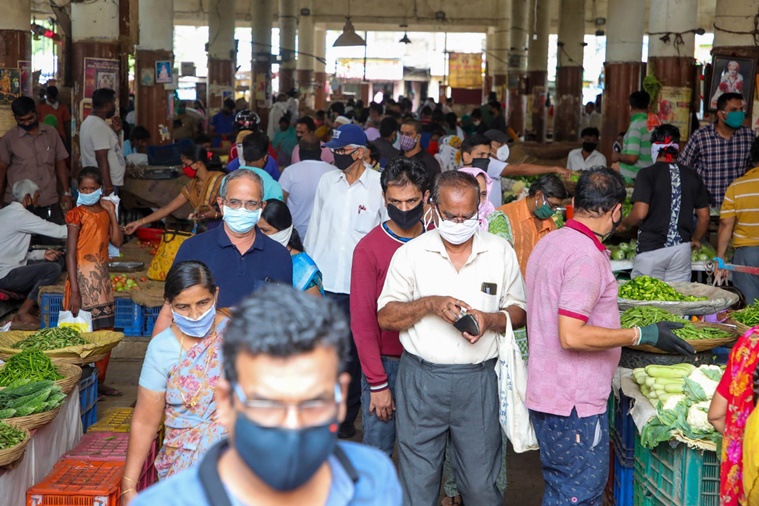Officially known as the Mahatma Phule Mandai, the city’s largest marketplace for vegetables and fruits remains a commercial hub to this day with its colonial heritage and Gothic architecture
Narsingh Thorat came to Mandai three decades after it was set up in 1886 as the Reay Market, and established a shop selling banana leaves. For over 100 years, BN Thorat and Sons Kelichya Pananche Vyapari has been occupying the same space under the original arches of the market. Run by Narsingh’s descendant Sagar Thorat, it offers neat pieces of banana leaves to buyers to this day. Other shops in the lane, too, deal exclusively in banana leaves, flowers and stems, and are run by fourth or fifth-generation descendants of the original owners.
“Our shop is where many families in Pune, hotels and event management companies have been coming for generations to get banana leaves to serve food to guests on special occasions. I will never shift as business is good in Mandai. With the rising interest in eco-friendly living, I have an idea to use banana leaves to create packaging, wraps and boxes as a substitute for plastic. I am exploring opportunities with a manufacturer in Kerala,” says Thorat. His attitude is exemplary of Mandai, where things remain the same while changing with the times.
Pune’s largest marketplace for vegetables and fruits, Mandai – officially the Mahatma Phule Mandai – marked its 135th anniversary on October 5. It remains a historical and commercial hub in Pune despite the establishment of Marketyard, another wholesale marketplace, in 1980. Here’s a look at what makes it a living heritage:
The chosen area

Colonial heritage
Mandai took shape in Shaniwar Wada, the old heart of Pune, where open-air grocery shops did brisk business. As the population grew and congestion increased, the municipality proposed moving Mandai to its present location of Shukrawar Peth. This was met with strong opposition from freedom fighter Lokmanya Tilak and social reformers Mahatma Jyotiba Phule and Hari Raoji Chiplunkar, among others, primarily because the cost of Rs 2.3 lakh was to be met from public funds. Nonetheless, the municipality acquired the land in 1882.
According to a marble plaque on the site, the complex was designed by WM Ducat and executed by architect Vasudev Bapuji Kanitkar and Ramchandra Godbole. When the Mandai was inaugurated in 1886, it was named after Lord Reay, the then Governor of Bombay. The design accommodated more than just shops for vendors. Reay Industrial Museum, the first public museum in Pune, was situated in the complex as was the office of the Pune Municipal Corporation (PMC) till it moved to Shivaji Nagar in 1966.
In 1938, Acharya PK Atre, a well-known writer as well as Chairman of the PMC Standing Committee, had the market renamed as Mahatma Phule Mandai. The museum was relocated to Ghole Road and rechristened as Mahatma Phule Museum.
Gothic architecture
Mandai stands out with its Gothic architecture. Designed like an octagon, it has an 80-ft tower and a tiled roof that used to keep the interiors cool. There are eight entrances, though all but two are closed due to the Metro construction work. For fruits and vegetables, you have to go to different dedicated sections of the Mandai.
Sahapedia, which has carried out a cultural mapping project of Pune, writes, “Four market wings housing the majority of the stalls radiate out from the ground floor verandah, their pitched roofs obscuring part of the upper verandah. Each wing comprises a nave (central part) and aisles and is supported by cast-iron columns, and the tiled roofs rest upon teak rafters. The wings are also provided with a narrow clerestory (higher windows) that casts light into the interior space and provides ventilation.”
An addition was made to the Mandai’s structure to mark a tragedy. In 1993, 38 students of Nath Hari Purandare Primary School were killed during a picnic when their bus was hit by a speeding train at the unmanned railway crossing in Phursungi. In their memory, a clock was installed from which the statue of a schoolboy would emerge out of a glass case every hour to ring the bell. Though the clock still tells the time, lack of upkeep has left the statue defunct.
Freedom struggle
As the freedom movement gathered steam, a clandestine radio station began to be operated from Abhyankar Wada behind Mandai. Speeches of Jayprakash Narayan, Ram Manohar Lohia and Yousuf Meher Ali were among those that were broadcast. In 2009, the Akhil Mandai Mandal put up a board to remind people of this protest. The radio station functioned until its members were arrested after a blast at Capitol Theatre on January 24, 1943.
Mandai and the area around it played host to a number of freedom fighters including Pt Jawaharlal Nehru and Sardar Vallabhbhai Patel. According to Sahapedia, “During India’s struggle for freedom, Mandai offered not just a local market but also an open ground for gatherings. Many important freedom fighters have addressed large crowds here, giving it the name Mandai Vidyapeeth (university). For instance, as per the Gazetteer, (Mahatma) Gandhi addressed several meetings in Mandai, the largest of which was attended by an audience of 10,000 people, where he was presented with a purse of Rs 5,152 by Dr VD Phatak. His speeches advocated the wearing of khaddar, which, in his opinion, was the only method of obtaining Swaraj.”
The city’s main market
Politicians, film stars, cooks, home chefs and heritage enthusiasts rub shoulders at Mandai, while filling their grocery bags from more than 500 shops. The market has been popular among families as well as businesses since the colonial era. “When we were children in the 1980s, Mandai was where our mothers would bring us to pick up the bags with the bribe of visiting a sugarcane juice stall or a sweet shop afterward. People across Pune come to shop in Mandai. If you go on a Saturday or a Sunday morning, you will find a huge mixed crowd, though vegetables and fruits are now easily available in the suburbs,” says Jayesh Paranjape, who conducts heritage walks as part of Western Routes. While some people swear by the fresh produce, others like the pricing at Mandai. Yet others enjoy having a range — you could get Talegaon batata, bin vasshache batata, dum aloo batata and Pahari aloo, among others, in a single shop. During Ganeshotsav, the space attracts lines of devotees who come to pray to the Akhil Mandai Ganpati, one of the oldest mandals of the city. The idol is of Ganpati and Sharada sitting on a swing.
The main marketplace of Mandai also led to the development of several shops around the area. Today, you can find rows of stores selling religious products as well as old families of basket weavers, bakery outlets as well as showrooms for fashionable clothes. “Until a few years ago, this was also a residential area. However, the extreme level of commercial activity over the past couple of decades has seen residents steadily moving elsewhere,” says Sandeep Godbole, a heritage researcher who lives in the neighbourhood. The metro is expected to bring about another transformation in Mandai, adding one more layer to its rich history.
Source: Read Full Article




